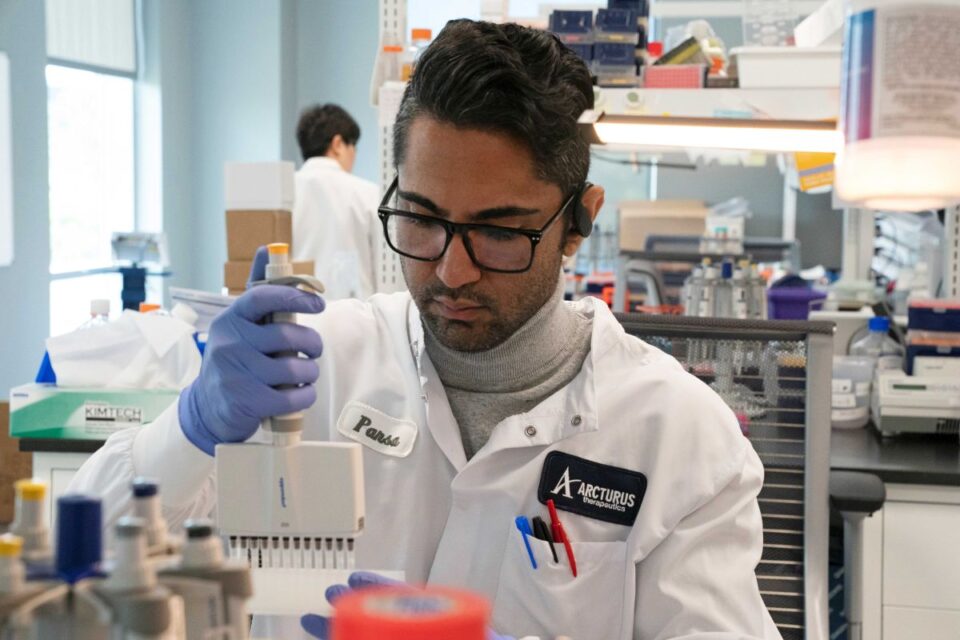‘You will not have a vaccine for everyone initially.’
IMAGE: Research assistant Parsa Parirokh of the RNA medicines company Arcturus Therapeutics conducts research on a vaccine for the novel coronavirus at a laboratory in San Diego, California. Photograph: Reuters
Two American companies have released early results of COVID-19 vaccines and both are quite positive about its efficacy.
Pfizer has announced 95% efficacy in the vaccine it has developed. On its heels came Moderna’s vaccine with an efficacy of 94.5%. Both are mRNA based vaccines. Pfizer’s vaccine has to be kept at a temperature of -70 degrees centigrade while the Moderna vaccine needed only -20 degrees centigrade.
Dr Anant Bhan, adjunct visiting professor at the Yenepoya (deemed to be a university), is a researcher in global health, health policy and bioethics.
He serves on the steering committee of the Global Forum on Bioethics in Research, and is the immediate past president of the International Association of Bioethics.
“We have never done a vaccination exercise of this scale. This has to target people across various age groups,” Dr Bhan tells Shobha Warrier/KhabriBaba.com.
As an expert on global public health, do you think the distribution of the Covid vaccine is going to be more challenging than fighting the pandemic itself?
They are both inter=related, but I wouldn’t say one is more complicated than the other because both are complex exercises.
As you know, we are dealing with a virus about which not much was known, and we are still learning. So, that itself was a challenge.
Our health system has been facing the onslaught of this pandemic, and it is continuing to be a challenge to respond. We have to admit that it is complicated.
Similarly, the vaccination exercise is also going to be a fairly complex and mammoth.
Why do you say it is going to be complex?
One, we have never done a vaccination exercise of this scale. This has to target people across various age groups.
If you look at our existing immunisation programme, it has largely targeted children and pregnant women. We have not had a vaccination programme which has targeted any other age group in a significant way.
It also means the vaccination delivery system is designed to fit the vaccination needs of these two populations, that is, children and pregnant women.
In the case of the Covid vaccine, we have to figure out how to reach, say, the older people, working adults, adolescents, school-going children, etc.
Then comes the issue of the number of doses of vaccine which need to be delivered because we have to immunise a very large number of people.
It also means the amount of resources required, the amount of vaccines required, storage of vaccine, transport of vaccine, etc.
All of these require a much, much larger scale than what we have been doing till now for our usual immunisation programmes. So, the scale of the immunisation programme itself will be a huge exercise.
The third element is that these are new vaccines. Some of them require specific storage requirements and conditions. It means we might have to come up with different infrastructure to enable that all across India. This again will be quite complicated.
Then, some of these vaccines need two doses within a short interval of 3-4 weeks, and that will need to be integrated into the logistics planning.
The Union health minister said they were going to use the services of the central armed police forces in the distribution of the vaccine. How much do you think that will help in the programme?
It depends on what role they play. They are not trained to do this; this is not part of their routine activities. Obviously, the armed forces or the reserved forces or the police forces are leveraged for various national exercises. A good example is the elections. They help with the transport of the election paraphernalia, provide security at the election booths, etc.
But the government needs to lay out the role of these forces in the distribution and roll out of the vaccine. Will they be involved in the transport? Will it be in ensuring security? It is not yet very clear what is their proposed role.
As a person working in public health, how do you think the government should be working on the distribution of the vaccine?
One, we need to learn from our past experiences. For example, we have done large immunisation campaigns for pulse polio. There is a whole supportive infrastructure built for that purpose. Since we are going to do something as a larger exercise, we have to see what we can learn from the best practices of these.
Second is, how best we can reach the large section of the population, what are the delivery points which will enable that, who should be able to support it, etc.
We need to train the health workers and volunteers for such an exercise. Then, should we be using the help of health workers like the Asha workers for the vaccination purpose?
Third is, how to ensure public support because there are a lot of people who have concerns about these vaccines. So, you have to build public trust in the vaccination programme.
Otherwise, you will have the vaccine, but people will not come forward to get vaccinated. So, you have to engage the public and see that they are on board.
That will also require the government to be transparent about the efficacy and safety of the vaccine, and also ensure the support of local leaders and networks.
It is accepted that the healthcare and frontline workers should be given first preference to the vaccine. Who should get the next preference?
Yes, there has to be a priority setting when you have a limited resource. You will not have a vaccine for everyone initially. So, you need to have some kind of an allocation framework which will be a priority setting exercise.
The government right now has decided to go with the healthcare workers, but it is not clear what criterion they have used for this. It can be based on who the critical service personnel are. It can be healthcare workers, sanitation workers, security workers, etc.
Then, it could be old people with co-morbidities, very young children, people who are involved in other public service like education.
The other questions are, is it based on the ability to pay? Or, is it based on political connections? So we need to know more details about how decisions on priorities are being taken.
Everyone needs to know the criterion that is going to be used in prioritising and the rationale behind the prioritisation.




